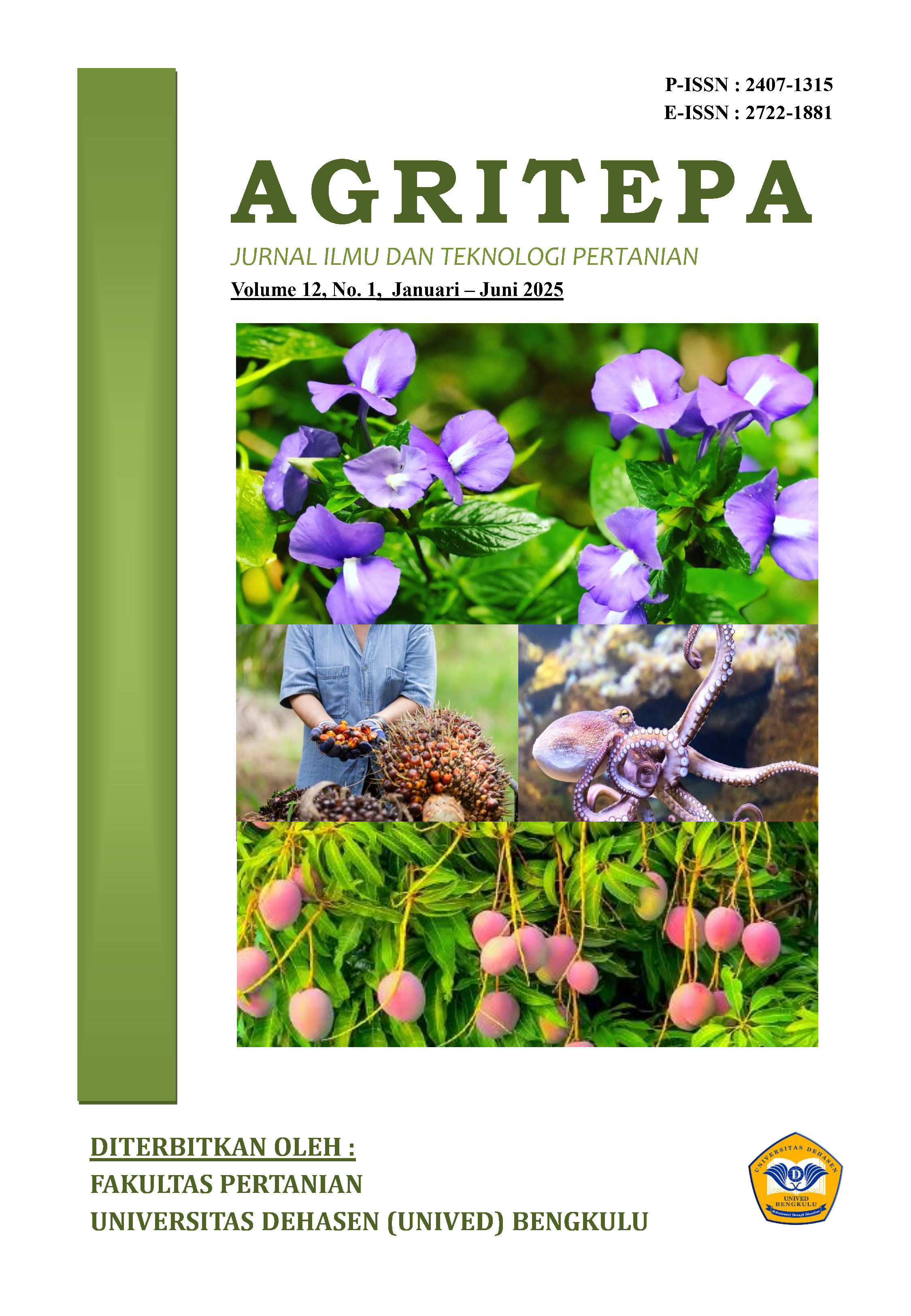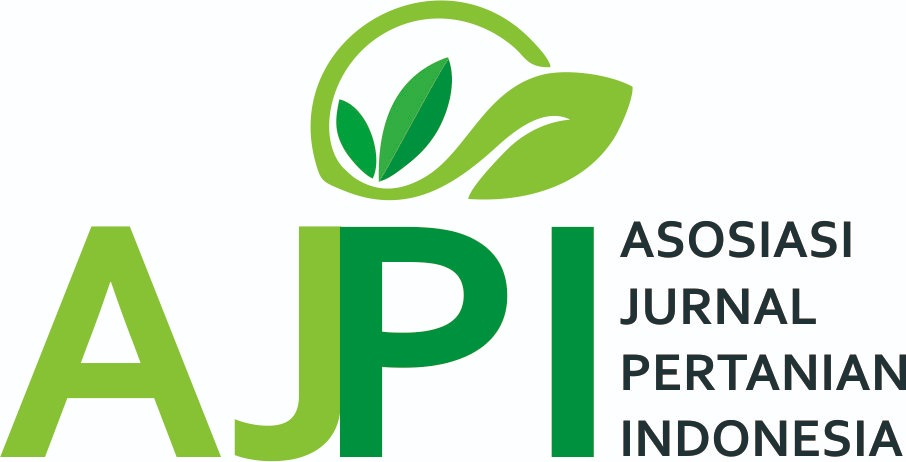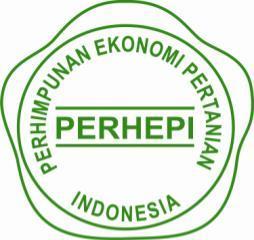Physicochemical Properties Of Sorghum (Sorghum Bicolor L.) Tempeh At Different Fermentation Times And Yeast Concentrations
Abstract
Purpose: This study aims to determine the effect of yeast concentration and fermentation duration on the physical characteristics (texture and colour) as well as the chemical properties (moisture content, protein content, fat content, and crude fibre content) of sorghum tempeh. Methodology: A factorial Completely Randomised Design (CRD) was employed, comprising Factor I: fermentation time of 42 hours (L1), 48 hours (L2), and 54 hours (L3); and Factor II: yeast concentrations of 1.5% (K1), 1.8% (K2), and 2.0% (K3), each with three replications. Data were analysed using Analysis of Variance (ANOVA) at a 5% significance level, followed by Duncan’s multiple range test for post hoc comparison. Results: In terms of physical texture parameters, hardness, springiness, and H value were not significantly affected (P > 0.05). However, significant differences (P < 0.05) were observed in colour values (L*, a*, b*, C), texture parameters (cohesiveness and chewiness), and chemical properties (moisture, protein, fat, and crude fibre contents), all influenced by both yeast concentration and fermentation duration. Findings: The optimal treatment was identified in sorghum tempeh fermented with 1.8% yeast for 48 hours, which enhanced cohesiveness, chewiness, fat content, moisture, protein levels, and crude fibre, while reducing the physical attributes of hardness, springiness, and H value. Novelty : This study reveals that both yeast concentration and fermentation time significantly influence the physical and chemical characteristics of sorghum tempeh. Originality: The research specifically investigates the impact of varying yeast concentrations and fermentation durations on the quality attributes of sorghum-based tempeh. Conclusion: The physical and chemical properties of sorghum tempeh are significantly affected by the concentration of yeast and the duration of fermentation. Article Type: Experimental Research Article.
Downloads
References
AOAC (Association of Official Analytical Chemist). (2005). Official Methods of Analysis, 18th edn. AOAC, Inc. Washington DC.
Badan Standarisasi Nasional. (2015). SNI 3144:2015 Tempe Kedelai. BSN. Jakarta.
Budianti Anita. (2018). Pengaruh Konsentrasi Ragi dan Lama Fermentasi Terhadap Sifat Kimia dan Organoleptik Tempe Kedelai Hitam (Glycine soja). Universitas Brawijaya. Malang.
Badan Pusat Statistik. (2020). Produksi Tanaman Sorgum. Jakarta : BPS
Badan Pusat Statistik. (2021). Rata-Rata Konsumsi per Kapita Seminggu Beberapa Macam Bahan Makanan Penting. Jakarta : BPS.
Barangmanise, S., Karundeng, Y., & Latif, Y. (2018). Kebiasaan Makan Makanan Tinggi Purin Pada Penderita Asam Urat Arthritis Rawat Jalan Di Puskesmas Tuminting. Dalam Prosiding Seminar Nasional Tahun 2018 ISBN: 2549-0931 (Vol. 1, No. 3, pp. 528-541).
Dyah Riniarsi Triyanti, M.Si. (2020). Outlook Komoditas Pertanian Tanaman Pangan Kedelai. Jakarta Selatan: Pusat Data dan Sistem Informasi Pertanian Sekteriat Jenderal Kementrian Pertanian.
Fauziah Ai Padhillah., Supriadin Asep., Junitasari Assyifa. (2022). Analaisis Pengaruh Konsentrasi Ragi dan Waktu Fermentasi Terhadap Nilai Gizi dan Aktivitas Antioksidan Tempe Kedelai Kombinasi Kacang Roay (Phaselus lunatus L). Dalam Prosiding Seminar Nasional Kimia. Vol.15.
Hanifah Aulia Nur. (2021). Pengaruh Lama Fermentasi dan Konsentrasi Jamur Rhizopus oligosporus Terhadap Karakteristik Tempe Biji Sorgum (Sorghum bicolor (L) Moench). Universitas Pasundan. Bandung.
Hutalugung, T. Y., Nainggolan R. J., dan Nurminah M. (2016). Pengaruh Perbandingan Kacang Hijau dan Biji Nangka Bergerminasi dengan Konsentrasi Laru terhadap Mutu Tempe. Jurnal Rekayasa Pangan dan Pertanian. Volume 4. No.3.
Herdiansyah Novi., Nur’aini Hesti., Darius. (2014). Pengaruh Jenis Tempe dan Bahan Pengikat Terhadap Karakteristik Nugget Tempe. Vol.1. No.1.
Jonaouskaite, D., Mohr, C., Antonietti, J.P., Spiers, P.M., Althaus, B., Anil Selin., Dael Nele. (2016). Most and Least Preffered Colours Differ According to Object Context: New Insights from an Unrestricted Colour Range. PLoS ONE 11(3): e0152194. Doi:10.1371/journal.pone.0152194.
Martinez,O., Salmeron,J., Guillen, M.D., and Casas, C., (2003). Texture Profile Analysis of Meat Products Treated with Commercial Liquid Smoke Flavourings. J. Food Control (15) 457 461.
Midayanto Dedy N., Yuwono Sudarminto Setyo. (2014). Penentuan Atribut Mutu Tekstur Tahu Untuk Direkomendasikan Sebagai Syarat Tambahan Dalam Standar Nasional Indonesia. Jurnal Pangan dan Agroindustri. Volume 2. No.4.
Mukhoyaroh, H. (2015). Pengaruh Jenis Kedelai, Waktu, dan Suhu Pemeraman terhadap Kandungan Protein Tempe Kedelai. Jurnal Florea, 2 (2), 47-51.
Purwanto Y.A., dan Weliana. (2018). Kualitas Tempe Kedelai Pada Berbagai Suhu Penyimpanan. Jurnal Agroindustri. Volume 35. No.2.
Puspitasari Diana., Nasir M., dan Azmin Nikman. (2022). Uji Organoleptik Tempe Biji Asam (Tamarindus indica) Berdasarkan Waktu Fermentasi. Jurnal Sains dan Terapan. Volume 1. No.1.
Rahayu Novia Aristi., Cahyanto M.N., Indrati Retno. (2019). Perubahan Protein Koro Benguk (Mucuna pruriens) Selama Fermentasi Tempe Menggunakan Inokulum Raprima. Jurnal Agriteknologi. Volume 39. No.2.
Raharjo Diana S., Bhuja Paulus., Amalo Djeffry. (2019). The Effect Fermentation On Protein Content and Fat Content Of Tempeh Gude (Cajanus cajan). Jurnal Biotropikal Sains. Vol.16, No.3.
Salsa Tahir,Yoyanda Bait, Arif Murtaqi Akhmad MS. (2025).Pengaruh Konsentrasi Ragi Pada Pembuatan Tempe Kacang Sacha Inchi (Plukenetia Volubilis L.). Jambura Journal of Food Technology (JJFT) Volume 7 Nomor 1 Tahun 2025.
Setyawan Ganang., Syamsul Huda. (2022). Analisis Pengaruh Produksi Kedelai, Konsumsi Kedelai, Pendapatan per Kapita, dan Kurs Terhadap Impor Kedelai di Indonesia. Volume 19, No.2.
Sofiyatin, R., Ketut, S., dan Lidya R. H. (2015). Studi Pembuatan Tempe Gude Dengan Berbagai Konsentrasi Ragi dan Lama Fermentasi Terhadap Sifat Organoleptik dan Sifat Kimia. Mataram : Poltekkes Kemenkes Mataram.
Sukarman., Astuti Dewi A., Utomo Nur B.P. (2017). Evaluasi Kualitas Warna Ikan Klown Amphiprion percula Lacepede 1802 Tangkapan Alam dan Hasil Budidaya. Jurnal Riset Akuakultur. Volume 12. No.3.
Standar Nasional Indonesia. (1992). Cara Uji Makanan Minuman (SNI 01-2891-1992). Jakarta : BSN.
Yulia Ruka., Akbar Zahlul., Irmayanti., dan Rita Sunartaty. (2019). Pengaruh Rasio Subtitusi Kacang Kedelai dengan Biji Melinjo dan Konsentrasi Ragi Terhadap Kualitas Tempe Kedelai. Jurnal Ilmu Pangan dan Hasil Pertanian. Volume 3. No.1.
Widiasri Ni Luh Putu., Husni Ali., Sutrisna Rudy., dan Liman L. (2024) Pengaruh Dosis Ragi Tempe Pada Pembuatan Tempe Tongkol Jagung Terhadap Kandungan Nutrisi Untuk Pakan Ternak. Jurnal Riset dan Inovasi Peternakan. Volume 8. No.1.
Widoyo Sylvitria., Handajani Sri., dan Nandariyah. (2015). Pengaruh Lama Fermentasi Tehadap Kadar Serat Kasar dan Aktivitas Antioksidan Tempe Beberapa Varietas Kedelai. Jurnal Biofarmasi. Volume 12. No.2.
Copyright (c) 2025 Khairiah Khairiah, Sakina Yeti Kiptiyah, Ismi Fathiya Khoirunnisa, Shefira Nurunazmi (Author)

This work is licensed under a Creative Commons Attribution-ShareAlike 4.0 International License.
Author retains the copyright and grants the journal the right of first publication of the work simultaneously licensed under the Creative Commons Attribution-ShareAlike 4.0 License that allows others to share the work with an acknowledgement of the work's authorship and initial publication in this journal













